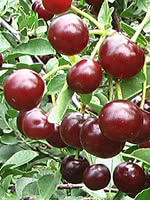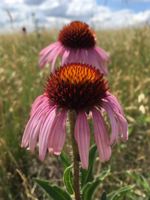Mon-Fri 9am - 5pm Mountain time
Carmine Jewel Cherry vs Narrow-Leaved Coneflower (Echinacea)
Prunus x kerrasis Carmine Jewel
Echinacea angustifolia
NOT AVAILABLE THIS SEASON - MIGHT RETURN
Carmine Jewel Cherry is a cold-hardy dwarf sour cherry. It is typically highly productive and one of the first varieties to ripen in summer. It produces deep red, tart fruit that are well-suited for fresh eating, baking, and preserves. In the spring, beautiful white flowers cover the branches, adding ornamental value.
Carmine Jewel Cherry was developed at the University of Saskatchewan. It is recommended to grow dwarf sour cherries as a shrub rather than a small tree. The shrub form tends to bear fruit earlier and is less susceptible to winterkill.
Sour cherries are self-fertile; however, planting with additional varieties for cross-pollination can increase yields.
Narrow-Leaved Coneflower is a native perennial wildflower known for its pink to pale purple, daisy-like blooms. The petals (rays) droop downwards, around a dark, domed center, giving the flower a cone-like appearance. The nectar-rich blossoms attract a wide variety of pollinators, including native bees and butterflies. After flowering, the seeds provide food for birds, further adding to its ecological value.
Once established, it is drought-tolerant due to its deep taproot, which also helps stabilize soil. Narrow-Leaved Coneflower thrives in a variety of well-drained soils, including sandy, rocky, and alkaline. It often grows alongside the native grasses that characterize prairie and grassland ecosystems, making it well-suited for prairie and grassland restoration, naturalization, and pollinator gardens.

